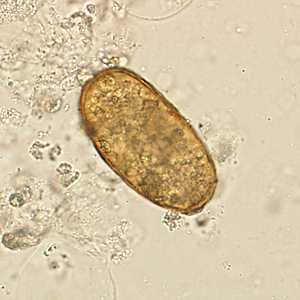
May - 2016 - Case #420
Sputum specimens were collected for routine microbiological work-up on an 18-year-old patient from Myanmar who presented with cavitary lung disease. The patient also had international travel to Malaysia and within the United States had visited Illinois, Indiana, and New York. During the examination of a wet mount of the sputum, suspicious objects were observed by the attending microbiologist (Figures A and B). The objects of interest measured on average 88 micrometers long by 43 micrometers wide. What is your diagnosis? Based on what criteria?

Figure A

Figure B
Case Answer
This was a case of paragonimiasis caused by a lung fluke in the genus Paragonimus. Diagnostic morphologic features included the presence of operculated, unembryonated eggs within the size range for Paragonimus species. Given the patient’s international and local travel, there were several possibilities of what the species in this case may have been including P. heterotremus (80-100 micrometers long by 55-65 micrometers wide) and P. westermani (80-120 micrometers long by 45-70 micrometers wide) in Southeast Asia, or P. kellicotti (83-100 micrometers long by 55-65 micrometers wide) in the Midwestern United States. The species in this case remains unresolved.
More on: Paragonimiasis
This case and images were kindly provided by the Indiana State Department of Health, Indianapolis, IN.
DPDx is an education resource designed for health professionals and laboratory scientists. For an overview including prevention and control visit www.cdc.gov/parasites/.
- Page last reviewed: August 24, 2016
- Page last updated: August 24, 2016
- Content source:
- Global Health – Division of Parasitic Diseases and Malaria
- Notice: Linking to a non-federal site does not constitute an endorsement by HHS, CDC or any of its employees of the sponsors or the information and products presented on the site.
- Maintained By:


 ShareCompartir
ShareCompartir